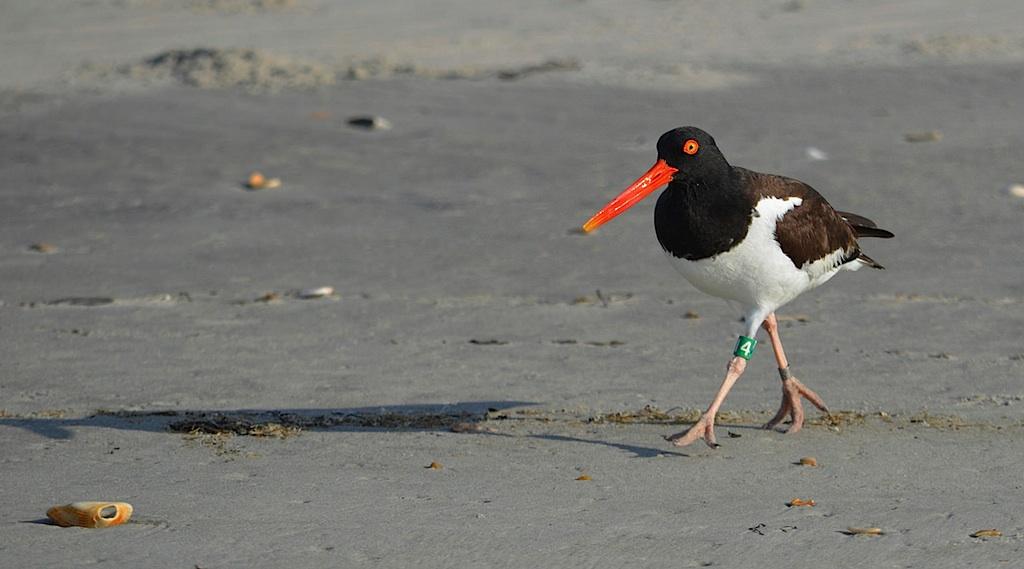This American oystercatcher, not-so-affectionately known as Gr14, has reared 9 chicks at Cape Hatteras National Seashore over the past decade.
Speak Softly And Carry....A Big Beak!

Support Journalism about National Parks!
National Parks Traveler is a 501(c)(3) nonprofit.
The Essential RVing Guide

The National Parks RVing Guide, aka the Essential RVing Guide To The National Parks, is the definitive guide for RVers seeking information on campgrounds in the National Park System where they can park their rigs. It's available for free for both iPhones and Android models.
This app is packed with RVing specific details on more than 250 campgrounds in more than 70 parks.
You'll also find stories about RVing in the parks, some tips if you've just recently turned into an RVer, and some planning suggestions. A bonus that wasn't in the previous eBook or PDF versions of this guide are feeds of Traveler content: you'll find our latest stories as well as our most recent podcasts just a click away.
So whether you have an iPhone or an Android, download this app and start exploring the campgrounds in the National Park System where you can park your rig.


You've got to be getting darn close to the bone, Lee, or he wouldn't be that defensive and spiteful.
All forms of access are NOT being blocked. To learn the truth, simply go to Hatteras' website and click on Park Alerts. Here is the summary of beach access as of the 15th of this month.
Summary Mileage Table - As of June 10, 2014
Bodie Island Area Total Mileage 5.74
Open to ORVs 2.19
Temporarily Closed for Resource Protection 0.89
Open to Pedestrians 2.67
Hatteras Island Total mileage 40.46
Open to ORVs 9.57
Temporarily Closed for Resource Protection 7.81
Open to Pedestrians 23.09
Ocracoke Island total mileage 17.87
Open to ORVs 7.51
Temporarily Closed for Resource Protection 3.99
Open to Pedestrians 6.36
Total Ocean & Inlet Shoreline 64.07
Total Miles Open to ORVs 19.26
Total Miles Temporarily Closed for Resource Protection 12.69
Total Miles Open to Pedestrians (Only) 32.12
Total Miles Open to Pedestrians (Includes ORV areas) 51.38
ALL access is blocked??????
I am not familiar with Hatteras, so I'm not sure what these next numbers mean, but there are 18 access ramps to reach the beach. Of those, 11 are open to ORV traffic and 15 are open to pedestrians.
ALL access is blocked? Hmmmmmmm.
Sounds like the Great American Entitlement Mentality is alive and well at CAHA.
The Great American Entitlement Mentality can be worse in places like NC, where the tea party culture runs rampant, and likes to destroy anything related to government. If some of them could have it like Mad Max, they would. This is a state that loosened environmental regulations so much that they drink coal sludge with their coffee, and bathe in it....and some of its residents think that is A OK. Next up is fracking, and you'll go to jail if you ever learn about all the dangerous chemicals they are dumping into the ground water table, because the tea party hacks they voted into state government made those rules.
A large portion of the Atlantic Coastline is swath in development. It's nice to think that there is still some wildness being protected on it. Beachdumb and his kind, just don't seem to get that.
I do take it personally, I hate telling my family we can't go again. These overly restrictive closures have changed our families traditions. While there is some beach access, the remote places we shared with kids, grand kids, and handicapped and elderly parents are closed. It's like going amusement park and all the best rides are closed. We don't use ORVs to drive on the beach for fun, it's the ONLY way to get to the beach for our family.
The NPS does not list the closures within the new pedestrian areas so actual open mileage is technically even smaller. I didn't say ALL beach access closed, I meant ALL forms of access to the beach are being affected by these closures. I realize you NPS fanboys are not very smart, that's probably why many of you work for the NPS.
Dumb, how about providing some solid documentation of your claims rather than reverting to insults?
Temporarily Closed for Resource Protection 0.89
Temporarily Closed for Resource Protection 7.81
Temporarily Closed for Resource Protection 3.99
Total Miles Temporarily Closed for Resource Protection 12.69
Does "temporarily closed for resource protection" not mean all access is blocked? He (and I) aren't stating there is no access to the beach at all, he is saying that areas are not just being blocked from ORV but to pedestrians as well. Your source indicates there at least 24 miles of beach where that is the case. And you didn't address his claim that the management plan has had no beneficial impact.
Nature can be a difficult subject to understand. I suppose if we (society) knew fully how it operates, all species would be doing great at Cape Hatteras.
Interestingly, while sea turtles had a record nesting year on the seashore in 2013, though "emergence" success was just 56 percent, compared to 73 percent in 2012. Why the change?
There also was a relatively good nesting season in 2013 for American oystercatchers, with 42 nests, the highest in six years. Yet the fledge rate was .55, down 1.3 in 2010 and 1.2 in 2011. Why? Bad weather, predation, humans, luck of the draw likely all played a role.
The fledge rate for piping plover in 2013 was roughly half what it was in 2005. Again, you have to wonder why.
You can find the annual reports at this page:
http://www.nps.gov/caha/naturescience/protected-species-2013-annual-repo...